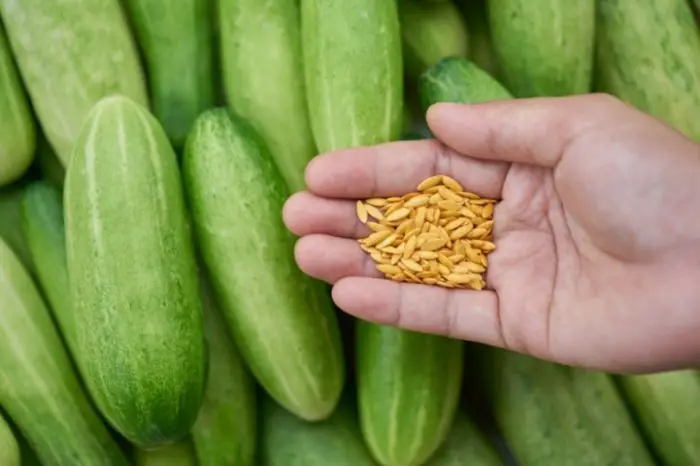Last Updated on February 28, 2023
Persian cucumber seeds are easily available in garden centers and online stores making them accessible to gardeners across America.
Persian cucumbers are classified as a single crop, also known as Cucumis melo var. flexuosus, belonging to the family of Cucurbitaceae. They are native to India but nowadays they are cultivated in many regions worldwide including Europe and North America. Persian cucumbers are also known as Beit Alpha, Middle Eastern cucumber, or Lebanese cucumbers.
The fruit length is between five to six inches. The fruits are cylindrically shaped with wrinkled skin covering firm flesh which can be white or green colored.
The plant growth habit is a bush type that has good resistance to pests, diseases, and drought conditions. One of the benefits of the Persian cucumber is that it requires very little space for growth since the plant size is small compared to others.
Growing Persian Cucumber Seeds
Growing Persian cucumber seeds is not difficult but their germination time is considered long. Persian cucumber planting requirements are different compared to other vegetable crops. These requirements include:
Planting depth
The seeding depth of Persian cucumbers is not recommended to be less than 1/2″ or more than 3/4″.
Seeding rate
The seeding rate for Persian cucumber seeds should be around four to eight lbs per acre depending on soil fertility.
Sowing time
The best time to sow Persian cucumber seeds is early spring after the frost danger period is over. These cucumbers are best suited to warmer areas with long summers. When sowing the soil temperature should be between 65 F to 70F for the best germination rate.
Seed spacing
Persian cucumbers are planted in rows with 60 cm between each row and from plant to plant should be at least 30 cm.
Health Benefits Of Persian Cucumber Seeds
Persian cucumbers are considered healthy, here are several health benefits they provide:
- Good Source of Antioxidants. Persian cucumbers are a good source of antioxidants which is necessary to keep the intracellular environment healthy and free from damage by free radicals.
- Rich in Vitamin C. Persian cucumbers is a significant source of Vitamin C which helps strengthen our immune system, improving skin health and reducing the risk for urinary tract infections.
- Rich in Dietary Fiber. Persian cucumber seeds contain a high amount of dietary fiber that is beneficial for the digestion system by regulating bowel movements and helping control blood sugar levels.
- Good for Skin. Persian cucumber seeds have been shown as a powerful weapon against acne, eczema, psoriasis, and sun damage due to their antibacterial properties.
- Anti-inflammatory Properties. According to a recent Persian cucumber study, these cucumbers have been found to carry a powerful anti-inflammatory food that can fight against arthritis and heart disease by preventing the development of inflammatory compounds in the body.
- Aids Weight Loss. Persian cucumbers are very low in calories making them ideal for weight loss diets. Many studies have shown that Persian cucumber seeds help to improve blood sugar levels in diabetic patients.
Click Here to Learn About:
How To Save Persian Cucumber Seeds?
When growing Persian cucumbers, you can save your own seeds from overgrown fruits. The best time to collect Persian cucumber seeds is when the fruits become yellowish or after they fall on the ground.
The Persian seeds should be allowed to dry at room temperature before storing them in a cool dark place. Both dried and fresh Persian cucumber seeds can be stored for a long time without losing their germinating ability.
Cucumber Seeds for Planting Outdoors 5 Variety Pack
Here are the steps to follow when saving Persian cucumber seeds:
- Step 1: Pick fruits when they are overgrown or have fallen on the ground.
- Step 2: Cut them open to reveal the seeds inside.
- Step 3: Scoop out the seeds and discard the fleshy part of the cucumber.
- Step 4: Spread the seeds in a dry place for several days until they are fully dried.
- Step 5: Store them in an air-tight container and place them in a cool dark room or cupboard.
Check Out The Differences Between Greensand Vs Azomite
How To Grow Persian Cucumbers From Home Seeds
Once you have saved your Persian cucumber seeds, it’s time to grow them again in the next season. Here are a few things to consider when growing Persian cucumbers from home seeds.
Ensure your soil is rich. When growing Persian cucumbers, you need to start with farm soil that is rich enough with organic matter, liming materials, and well-drained. The pH level should be between 6.5 to 7.5 which can be achieved by adding limestone on-farm soil before planting your home seeds.
Water them regularly. Persian cucumbers require a lot of water to grow healthy and produce a high yield. They should be watered regularly during the growing season every day until fruits are harvested to keep the soil moist.
Protect them from plant enemies. Persian cucurbit seeds are vulnerable to fungal infections such as Downy mildew, powdery mildew, and bacterial wilt.
It’s important to take preventive measures against these fungi during the growing periods by using disease-free planting material. In addition, Persian cucumber seeds can be treated with fungicides for better results.

Conclusion
Persian cucumber seeds as described in this article are a little difficult to germinate and therefore require the best growing conditions.
The best growing conditions for this plant include rich soil that is well-drained, enough water, protection from plant enemies, and good air circulation.
If you choose to save your own seeds, remember to dry them completely and store them in a cool dark space. You can store your seeds long enough but you need to check them from time to time for any fungal infections that may lead to rot.
You can incorporate these scrumptious vegetables in several recipes like salads, dips, stews, and curries.
FAQ’s
What variety are Persian cucumbers?
The most common variety of Persian cucumbers is burpless. There are several other varieties including lemon, San Diego market, long green etc. The largest variety is the burpless cucumber which has a mild, sweet flavor.
Are Persian cucumbers easy to grow?
When compared to other cucumber types, Persian cucumbers are a little trickier to grow. They prefer warmer climates and should be planted after the soil temperature has reached at least 60 degrees Fahrenheit.
Persian cucumbers require a moderate amount of water during the growing season so they may not survive in locations where summer rainfall is very scarce.
How can I save Persian cucumber seeds?
If you wish to save Persian cucumber seeds, separate the seeds from Persian cucumber flesh after harvesting them. Rinse the cucumber pulp in water to remove any dirt or debris left behind.
Spread the Persian cucumber seeds out on a paper towel to dry for about two weeks before storing them in an airtight container placed in a cool dark room or cupboard. Persian cucumber seeds can be stored for many years without losing germination ability if properly dried and stored for future use.
Can I grow Persian cucumber from home seeds?
When growing Persian cucumbers from home seeds, the process is very simple and straightforward. The Persian cucumber plant needs full sun exposure in order to produce fruits. They are known as warm-season crops that prefer soil temperature of at least 65 F or higher for the best germination rate.
Sowing Persian cucumber seeds directly into garden beds or containers should give you the same great results since both methods work well if you provide proper care to your plants.

Lory is an avid gardener who loves spending time outdoors. She is passionate about using her green thumb to create beautiful, lush gardens for her friends and family. She finds joy in tending to her garden, trimming plants, and cultivating new species. She loves to share her knowledge and experience with others who have a similar enthusiasm for gardening. Lory is a true nature enthusiast who loves to share her enthusiasm for the outdoors with all who meet her.

